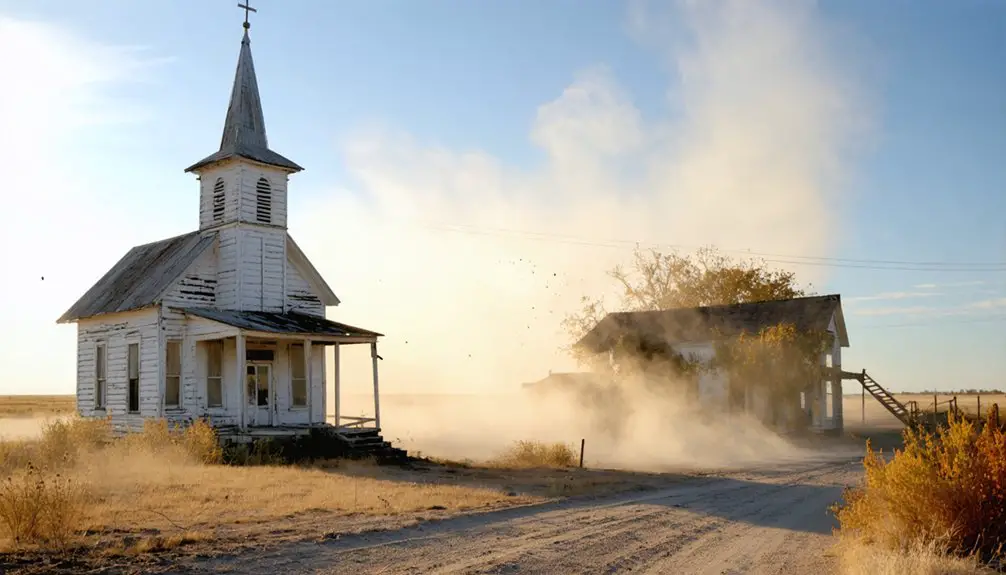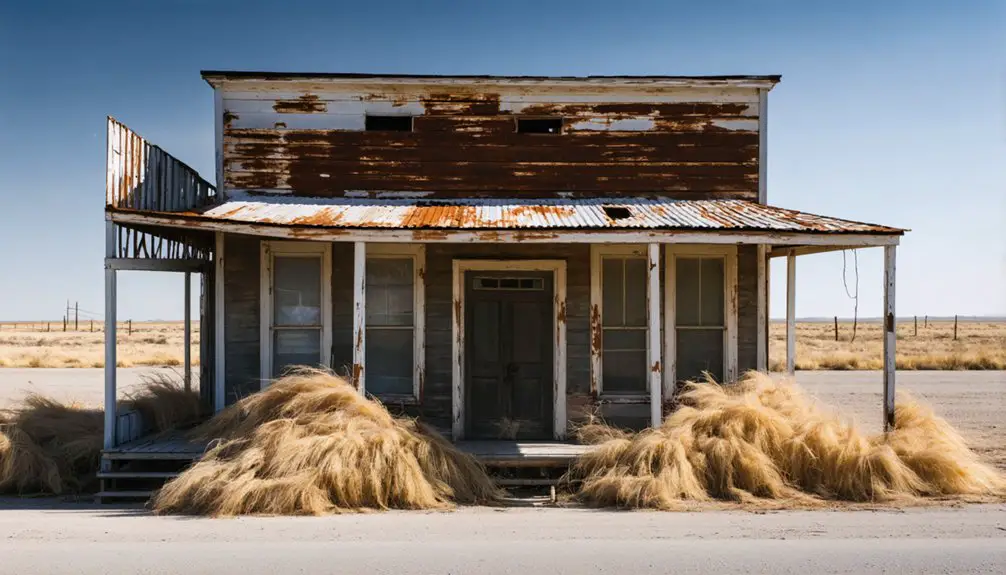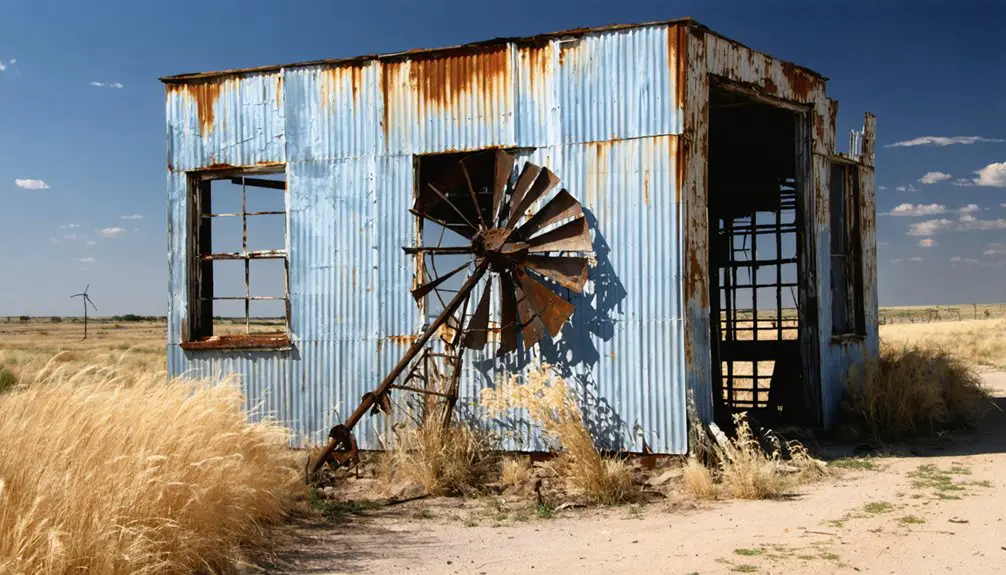You’ll find Close City among Texas’s fascinating ghost towns, originally established as Ragtown in the mid-1850s near Burrett Creek. The settlement transformed after Charles William Post purchased 200,000 acres in 1907, introducing innovative farming techniques and building essential community structures like the Algerita Hotel and a brick schoolhouse. Though it peaked at fifty residents in the 1930s, Close City’s abandoned buildings now tell a deeper story of agricultural ambition and pioneer spirit.
Key Takeaways
- Close City was established near Burrett Creek in Texas during the mid-1850s, originally named Caddo before becoming known as Ragtown.
- The town reached its peak population of fifty residents in the 1930s and was named after E.B. Close, Post’s son-in-law.
- C.W. Post purchased 200,000 acres in 1907 to develop the community, introducing irrigation projects and promoting cotton farming.
- The brick schoolhouse built in 1919 remains a historical landmark, serving the community until its consolidation with Post schools in 1965.
- Economic decline occurred due to shifting agricultural markets, modernized farming practices, and the rerouting of major transportation routes.
The Rise of Ragtown
When pioneer Benjamin B. Haney settled near Burrett Creek in the mid-1850s, he sparked what would become a bustling tent city.
You’ll find this settlement’s roots in what settlers first called “Caddo,” though it quickly evolved into the more colorful name of Ragtown. The strategic location near Amarillo Creek proved essential, positioning the community at the crossroads of emerging cattle trails and railroad interests.
As railroad construction kicked into high gear near Wild Horse Lake, Ragtown transformed into a magnet for railroad workers seeking opportunity. The town grew rapidly as railroad executives built new lines through the area.
The town’s character reflected its frontier spirit, with saloons, gambling halls, and other establishments catering to the transient workforce. The community reached its peak when fifty residents called it home in the 1930s.
While it wouldn’t appear on maps until after 1900, Ragtown’s role as a railroad hub shaped its early identity and growth.
Charles William Post’s Vision
While Ragtown grew organically as a railroad settlement, a different vision emerged nearby in 1907. C.W. Post, the cereal magnate, purchased over 200,000 acres along the Caprock Escarpment in Garza County to create his ideal community.
Post’s aspirations went far beyond mere town-building – you’ll find his blueprint reflected a utopian dream where hard-working families could achieve self-sufficiency through innovative farming.
He designed wide streets and a central square to foster community cohesion, while introducing irrigation projects and dry-land farming techniques to transform the semi-arid landscape. He collaborated with agricultural experts to promote sustainable farming and ranching practices. The town quickly established itself with the construction of the Algerita Hotel, which became a hub for social and business activities.
You can see his experimental spirit in everything from the textile mill he built to his dramatic attempts at rainmaking using dynamite.
Though his mental health struggles intensified in later years, Post’s planned community became the county seat and left an indelible mark on West Texas development.
Early Development and Community Life
Though initially established as “Ragtown,” Close City emerged as a small farming settlement on the Llano Estacado after being renamed for E.B. Close, C.W. Post’s son-in-law.
From humble Ragtown beginnings, Close City took root on the Llano Estacado, bearing the name of Post’s son-in-law E.B. Close.
You’ll find that cotton dominated the agricultural landscape, with farmers also growing sorghum and winter wheat to diversify their crops. Local farmers rely on center-pivot systems for efficient irrigation of their fields.
The community’s heart centered around its one-room wooden schoolhouse built in 1909, later replaced by a brick structure in 1919 built by locals George Samson and Jimmie Napier. Like many aging ranching families today, some residents eventually sold their land and moved away.
Community gatherings and rural traditions flourished around school activities until 1965, when Close City consolidated with Post schools.
While the BNSF Railway bypassed the town by 5 miles and limited transportation options kept the settlement small, many original residents maintained their farming roots in this tight-knit community.
Notable Structures and Architecture
You’ll find the historic Toyah High School building standing as one of Close City’s most prominent architectural landmarks, complete with its original furnishings and fixtures.
The Hicks-Cobb general store maintains its authentic retail design, offering a glimpse into early Texas commercial architecture.
Several church buildings, though weathered by time, showcase the town’s religious heritage through their period-specific construction methods and layouts. Like many ghost towns, Close City features construction utilizing clay brick materials produced during local mining operations.
The town once featured an impressive cotton gin facility, which served as a Union Pacific depot during its heyday.
Historic School Building Remains
Standing as the most prominent remnant of Close City’s past, the brick schoolhouse built in 1919 by George Samson and Jimmie Napier replaced an earlier one-room wooden structure from 1909.
You’ll find this historic building along Highway 399, six miles west of Post, Texas, where it served the community until 1965.
The brick construction, uncommon for rural schools of that era, reflects the town’s commitment to education and community identity.
While the building now shows signs of weathering and neglect, it remains a symbol of early 20th-century frontier schoolhouse design.
Captured with a Canon EOS 5D camera in 2011, the structure’s deteriorating state has been documented to preserve its historical significance.
Like the Toyah School building in Reeves County, this structure stands as a testament to the changing dynamics of rural communities.
Despite limited historic preservation efforts, the abandoned structure continues to be a significant landmark, embodying the cultural heritage of West Texas ghost towns and the broader story of rural school consolidation that changed the landscape of Texas education.
Original Retail Store Design
The original retail landscape of Close City centered around classic Western frontier architecture, featuring wood-frame buildings with false-front facades along the main thoroughfare.
You’ll notice the ghost town commerce revolved around a traditional general store design, with wide covered porches that once provided shelter and served as informal gathering spots for locals.
The retail architecture incorporated locally sourced materials, including native stone foundations and rough-cut lumber typical of Texas frontier construction.
The store’s interior featured wooden shelving, service counters, and a potbelly stove for heating.
Like many similar establishments of its era, the building combined multiple functions, housing dry goods, groceries, and possibly postal services, all arranged in a practical layout that maximized the compact retail space.
Church Architecture and Layout
Among Close City’s most enduring structures, its brick church building represented a significant architectural advancement from earlier wooden buildings in the settlement.
You’ll find classic Gothic Revival influences in its vertical design elements and pointed arch windows, though many features have deteriorated over time. The church’s traditional linear layout leads you through a central aisle to an elevated altar, while large windows once illuminated the sanctuary with natural light.
The brick exterior’s rich red hue stands in stark contrast to the surrounding ghost town landscape, embodying both church symbolism and architectural preservation efforts.
While the bell tower has partially crumbled, the building remains a reflection of the community’s former prosperity and spiritual aspirations, now serving as a historical landmark for visitors exploring Texas ghost towns.
Economic Factors Behind the Decline
Close City’s decline closely mirrored many Texas ghost towns that suffered from shifting agricultural markets and changing transportation patterns.
You’ll find that the town’s agricultural base weakened as farming practices modernized and consolidated in the region, reducing the need for smaller agricultural centers.
The rerouting of major transportation routes away from Close City further isolated the community, leading to a decrease in commerce and eventual population loss.
Agricultural Market Changes
As farming operations across Texas faced mounting economic pressures in recent decades, Close City experienced a dramatic agricultural decline that mirrored statewide trends.
You’ll find that market adaptation and agricultural innovation weren’t enough to save many local farms as they struggled against rising costs and regulatory burdens.
Here’s what changed the agricultural landscape in Close City:
- The loss of traditional farmers’ markets and direct sales opportunities crippled small producers’ ability to reach local customers.
- Rising operational costs and labor shortages made it impossible for many farms to remain profitable.
- Market consolidation favored large distributors, pushing out smaller independent farmers.
- Price volatility in agricultural commodities hit small operations particularly hard, forcing many to shut down.
These market shifts fundamentally altered Close City’s farming community, contributing to its eventual ghost town status.
Transportation Routes Shifted
While railroads once served as Close City’s economic lifeline, major shifts in transportation infrastructure during the mid-20th century severely impacted the town’s importance.
You’ll find that Texas’s transportation history underwent dramatic changes as personal automobiles and buses replaced rail service. The state’s focus shifted heavily toward highway expansion, bypassing smaller communities that had relied on rail connections.
As rail infrastructure declined across Texas, with stations being demolished and service frequency reduced, towns like Close City lost their essential transportation links.
You’ll notice this wasn’t unique to Close City – many rural Texas communities faced similar fates when highway routes redirected traffic and economic activity elsewhere.
The lack of investment in regional transit options, combined with the removal of crucial rail connections, left these once-thriving railroad towns increasingly isolated from major economic centers.
Religious and Educational Heritage

During its early years as “Ragtown,” Close City’s religious and educational foundations emerged from humble beginnings, with residents living in tents before establishing permanent structures.
Religious gatherings strengthened community bonds while supporting the social experiments initiated by C.W. Post’s family. You’ll find the educational impact most evident in the progression from a wooden schoolhouse in 1909 to a brick facility in 1919.
- The one-room wooden schoolhouse served as both an educational center and community gathering place
- The 1919 brick schoolhouse represented significant community investment
- Religious institutions helped establish social structure and moral framework
- School consolidation with Post in 1965 marked the end of an era
These foundations reflected the town’s commitment to building a stable, morally structured community despite its temporary origins.
Ghost Town Legacy Today
Today, Close City stands as a tribute to Texas’s rich pioneer heritage, with abandoned structures serving as silent storytellers of its past. You’ll find the old school building among other deteriorating structures, offering tangible connections to the community’s former significance.
While ghost town tourism remains modest here, the site exemplifies the broader challenges facing Texas’s abandoned settlements.
Like many ghost towns, Close City faces ongoing battles with physical decay and limited preservation resources. Yet, these remnants play an essential role in cultural preservation, helping you understand the area’s settlement patterns and community evolution.
Though visitor numbers stay small, dedicated history enthusiasts continue to explore these grounds, documenting stories and artifacts that might otherwise fade into obscurity, ensuring Close City’s legacy endures for future generations.
Historical Significance in Texas Settlement

As C.W. Post envisioned a model community in West Texas, Close City emerged as a fascinating example of early 20th-century settlement patterns.
You’ll find its story intertwined with the ambitious dreams of planned communities and the practical realities of rural Texas life.
- The town’s change from Post’s social experiment to a farming community reflects the shift in Texas settlement dynamics, where agricultural needs often trumped planned development.
- Close City’s community identity was shaped by cotton farming, with the Ogallala Aquifer enabling both dryland and irrigated agriculture.
- The evolution of its educational facilities, from a one-room schoolhouse to consolidation, mirrors broader rural development trends.
- State laws governing county seat locations ultimately altered Close City’s destiny, demonstrating how legislation influenced Texas settlement patterns.
Frequently Asked Questions
What Happened to the Original Residents of Close City?
Your original settlers split between moving to Post when the county seat relocated and staying in Close City. Most who stayed eventually left due to declining opportunities throughout town history.
Are There Any Supernatural Legends Associated With Close City?
You won’t find documented haunted sightings or ghost stories from Close City. Unlike many Texas ghost towns with rich supernatural folklore, there’s no historical evidence of paranormal legends in this farming community.
Can Visitors Legally Explore the Abandoned Buildings Today?
Unlike 90% of Texas’s accessible ghost towns, you can’t legally explore Close City’s abandoned buildings without owner permission. There aren’t any sanctioned ghost tours, and private property legal restrictions strictly apply.
What Was the Peak Population of Close City?
You’ll find that while the exact peak population isn’t documented, historical records suggest it likely reached several hundred residents in the early 1900s, similar to comparable ghost towns in the region.
Does Anyone Maintain or Own the Remaining Structures?
While you might expect historical preservation efforts, there’s no documented ownership or active maintenance of the remaining structures. Like many Texas ghost towns, they’re likely abandoned or minimally maintained by occasional caretakers.
References
- https://www.county.org/county-magazine-articles/summer-2025/ghost-towns
- https://mix941kmxj.com/see-how-two-texas-ghost-towns-battled-for-the-county-and-lost/
- https://www.youtube.com/watch?v=phjUE19A8HM
- https://www.chron.com/life/travel/article/ghost-towns-texas-18425049.php
- https://www.tshaonline.org/handbook/entries/close-city-tx
- https://mansfieldphoto.com/journal/7-texas-ghost-towns/
- https://en.wikipedia.org/wiki/List_of_ghost_towns_in_Texas
- https://commons.wikimedia.org/wiki/File:Close_City_Texas_abandoned_school.jpg
- https://www.texasescapes.com/TexasPanhandleTowns/Close-City-Texas.htm
- https://truewestmagazine.com/article/ragtown-to-riches/



